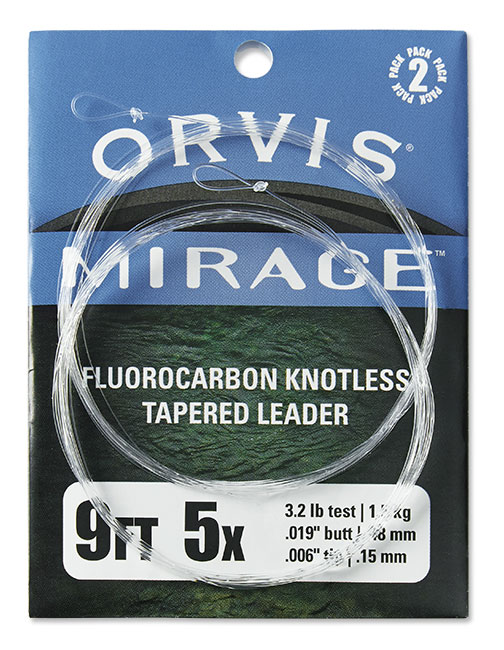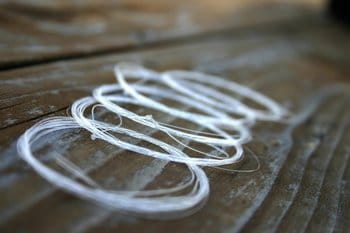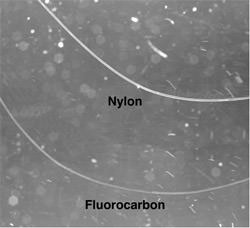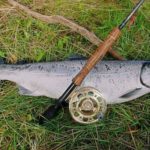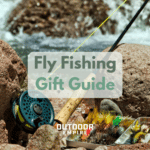Fly fishing is all about stealth. If your fly lands on the water with only a hint of a ripple and drifts downstream free of drag, there’s a good chance that an unsuspecting fish may mistake your artificial for the real thing.
But how is it possible to achieve a stealthy presentation (aside from having a good fly reel and matching rod) with a fly line that is brightly colored, heavy, and prone to splashdown landings?
Enter the leader.
How it Works
A fly leader is the clear fishing line, often monofilament, that connects your lightweight fly to your heavy fly line (learn more about the functions of fly line here).
While a fly leader is essential for a delicate fly presentation, it’s even more critical for executing proper fly casting mechanics.
For a fly to hit its target, the energy stored in the fly line must be transferred to the tip of the leader. Since a fly leader is tapered from thick to thin, it allows the energy to move through and unfurl the fly line as it straightens, propelling the fly towards its target.
Three Leader Parts
Butt Section
The butt section is where the leader attaches to the fly line and is the thickest portion of the leader. For most fly leaders, the butt section ranges from 12 inches to over 3 feet long.
Middle or Tapered Section
After the butt section, the leader gradually becomes thinner until it reaches the thinnest point at the very end — the tippet.
Sandwiched between the butt section and the tippet, the middle section is generally one-third the length of the entire leader. But can vary depending on leader design, overall length, and severity of the taper.
Tippet
The last section of the leader is the tippet, the thinnest section where you tie on your fly. It can be as short as 6 inches or as long as 7 or 8 feet, depending on how you’re fishing.
The tippet is softer and more supple than the butt and middle sections, giving your fly the freedom to move in the water with the least amount of drag.
During a typical day of fishing, the tippet section of a leader gets shorter as you continuously cut it to change flies. To avoid changing the entire leader when the tippet gets too short, carry extra spools to replace the cut off and re-tied portions.
Types
Knotless Tapered
The vast majority of leaders used by fly anglers are knotless tapered leaders.
These fly fishing specialty items are made of a single strand of monofilament line that is extruded from a machine which imparts the proper taper to the leader complete with butt, middle, and tippet sections.
They come in many different strengths, lengths, and tapers to catch nearly any fish species, from mountain stream brook trout to fly-crushing salt marsh redfish.
Anglers favor knotless tapered leaders over other varieties for their simplicity and ease of use. All you have to do is open the package, attach the leader to your fly line, tie your fly to the tippet and you’re ready to fish.
Most knotless tapered fly leaders even come with a loop tied in the butt end which allows you to attach the leader to your fly line with a simple loop-to-loop connection instead of fussing with knots.
Knotted Tapered
Knotted tapered leaders are just like knotless tapered ones. But instead of being made from a single piece of continuously tapered monofilament, they are made with a series of monofilament sections of different sizes and strengths that are knotted together to form a taper.
If you want to fish with it, you pretty much have to tie them yourself as they aren’t manufactured and sold in fly shops. While it takes extra effort to tie your own knotted leaders, you have complete control over the length, strength, and the proportions of the taper.
It takes lots of trial and error to figure out the best proportions to use so that your knotted leader casts well, which is why most anglers opt for readily available knotless tapered leaders.
Material
Monofilament
The majority of knotless tapered leaders on the market are made of nylon monofilament. It is relatively inexpensive, very durable, and is available in a wide range of sizes.
Nylon monofilament, mono for short, is slightly less dense than water which causes it to float or at least remain neutrally buoyant. It is also slightly porous, and it absorbs some water which keeps the line soft, supple, and flexible.
This is exactly what you want your leader to be to make a natural fly presentation.
Monofilament also has high elasticity, meaning it stretches and also recoils. A monofilament leader acts like a shock absorber at the end of the line, providing an excellent cushion when setting the hook on a fish.
Fluorocarbon
Knotless tapered leaders are also available in fluorocarbon, which is thought to be more specialized than monofilament. It’s also considerably more expensive than mono.
Fluorocarbon is a much denser and harder material than nylon monofilament. The increased density gives fluorocarbon greater durability, especially in terms of abrasion resistance, which is why many saltwater anglers choose fluorocarbon when fishing over line-cutting coral reefs.
The higher density of fluorocarbon makes it less elastic than nylon monofilament. With less stretch and recoil, fluorocarbon is often touted as providing a better feel of the line, the fly, and the fish.
It’s also thought to provide better hook setting power, as fewer stretch results in a better transfer of energy when striking.
Lastly, it is less visible in the water than monofilament. Some say it “disappears” in the water, but this is mostly just wishful thinking. Fish have great underwater eyesight and can see fluorocarbon, just slightly less so than monofilament.
The “X” System
Fly leaders come in a wide range of breaking strengths for both freshwater and saltwater fishing. But while the strength of a standard fishing line is expressed in pound-test, fly leaders and tippet are rated using an “X” system — OX, 1X, 2X, 3X, up to 8X.
The X system may seem confusing at first because the smaller the number, the stronger the leader. For example, a 2X leader is much stronger than a 6X leader.
Finally, the size of the leader marked on the label (3X, 4X, etc.) tells you the size of the tippet — the thinnest part of the line.
Most trout fishing is performed with leaders in 5X, 6X, and 7X sizes. For species like largemouth bass and northern pike, leaders in 2X and 3X are better suited.
Most saltwater fly leaders, however, do in fact use a pound-test breaking strength system ranging from 8 pound-test up to 60 pound-test or more.
Aspects Affected by Leader Length
The length of a leader affects three main aspects of fly fishing: casting, fly presentation, and depth of fly.
Casting
For most anglers, the longer the leader, the harder it is to cast.
For optimal fly casting performance, it’s widely held that the leader should be the same length as the rod.
So, if you have a 9-foot fly rod, a 9-foot long leader is a perfect match. Of course, you may find that your particular 9-foot rod casts better with an 11-foot leader, and your friend’s cast better with an 8.5-foot leader.
Fly Presentation
In terms of fly presentation, the longer the leader, the less likely you are to spook fish.
A long leader keeps the fly further away from the heavy fly line and offers a more gentle water landing. However, it’s typically more difficult to cast a long leader with accuracy.
As with most things in fly fishing, it’s a trade off.
Depth
The length of a leader also determines how deep a fly sinks, particularly when using a floating fly line. This can be used to your advantage if you find yourself in a situation where you need to get your fly down deep, but don’t have a sinking or sink tip line at your disposal.
Add an extra 3 or 4 feet of tippet to your leader and gain some extra depth.
Experiment Until You Catch Fish
Fly leaders can be very finicky, requiring much tweaking and tinkering until you find what works for you. If you’re just starting out, keep things simple and use knotless tapered leaders in the appropriate strength for your quarry in length equal to your rod.
Be sure to pick up a couple extra spools of tippet, one in the same size as your leader, and another the next size up in case you need to rebuild part of your leader’s taper. Tie on your fly and start fishing.
Keep experimenting with different leader materials, strengths, and lengths until your casting feels good and your presentations are attracting fish.

